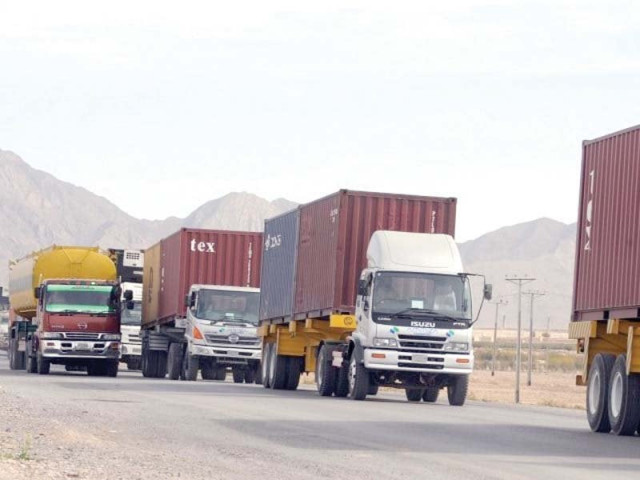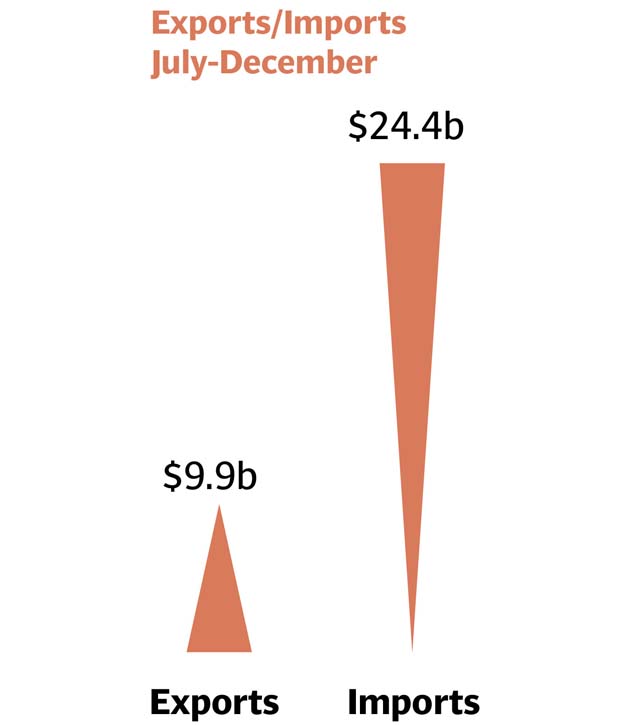July- December: Trade deficit widens to $14.5b, December exports fall again
Shortfall was alarmingly 71% of annual projection of $20.5 billion

The country’s foreign financing requirements for this fiscal year are projected in the range of $12 billion to $15 billion, depending upon the projections of exports and imports. PHOTO: FILE
The gap between exports and imports during the July-December period of fiscal year 2016-17 stood at $14.5 billion, reported the Pakistan Bureau of Statistics (PBS) on Monday. The trade deficit was alarmingly 71% of the annual projections of $20.5 billion, suggesting that the government will face serious problems in meeting its external account targets, according to experts.
Exports plunged 3.82% to $9.9 billion during the July-December period of this year, which was $394 million less than the exports made in the comparative period last year. Compared to this, the import bill increased 10.2% to almost $24.4 billion in the same period. In absolute terms, the import bill was $2.24 billion more than the previous year.
Except import of machinery, the government will have to curtail all other imports, said Dr Hafiz Pasha, the former finance minister. He said that the first-half trade results are worrying.
Although the detailed account of the trade deficit for the first half was not available, during the first five months Pakistan imported $1.42 billion worth of power generation machinery. Most of this was under the China Pakistan Economic Corridor (CPEC) framework but since CPEC-related financing is not investment, the influx of imports has started affecting the trade balance of the country.
The $14.5-billion trade deficit during the first half of this year was $2.63 billion or 22.2% more than the previous year. During the first half of the last fiscal year, the trade deficit had been clocked in at $11.9 billion.
For fiscal year 2016-17, the government has projected that exports would grow to $24.75 billion and import bill may remain at $45.2 billion by end of this fiscal year. It had projected $20.5 billion trade deficit for the whole fiscal year. However, the first six-month results showed that the deficit might touch $24 billon by the end of the fiscal year, as the trade deficit in July-December period was 70.7% of the annual target.
The higher than projected trade deficit would increase the government’s reliance on foreign borrowings to meet its external account requirements. The country’s foreign financing requirements for this fiscal year are projected in the range of $12 billion to $15 billion, depending upon the projections of exports and imports.

The government closed the last fiscal year 2015-16 at an eight-year low level of exports, which dropped to $20.8 billion despite preferential access to European markets. The exports have been declining since the current government took over, falling from $24.5 billion in 2012-13.
Annual results
The increase in exports during November turned out to be a one-time phenomenon, as the exports slid again last month. The exports in December stood at $1.72 billion, showing a decline of over 3% when compared with the results of the December last year, according to the PBS. In absolute terms, the exports were down by $55 million.
However, the growth in imports jumped to 17.6% and stood at $4.5 billion in December, which were $671 million more than last December’s imports. The trade deficit last month increased alarmingly to $2.8 billion, which was 35.7% more than the comparative month of the preceding year.
Even on a monthly basis, the trade deficit widened 11.9% in December over previous month. In absolute terms, the trade deficit was $2.8 billion. The exports were 2% down in December over November while imports grew 6.1%.
A recent study by the World Bank showed that exports in South Asian economies remain highly concentrated in textiles and apparel and these countries need to shift to value addition to get a better price of their products.
Published in The Express Tribune, January 10th, 2017.
Like Business on Facebook, follow @TribuneBiz on Twitter to stay informed and join in the conversation.


















COMMENTS
Comments are moderated and generally will be posted if they are on-topic and not abusive.
For more information, please see our Comments FAQ